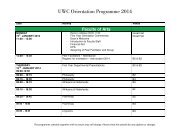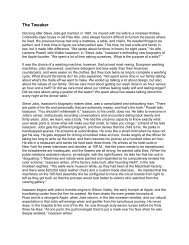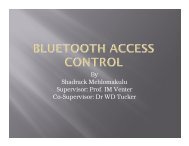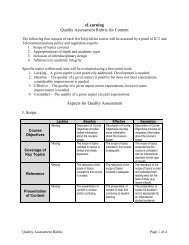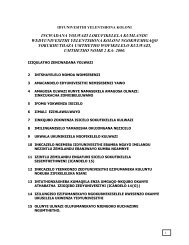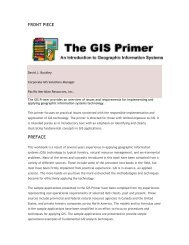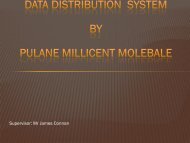Ecosystem Guidelines for Environmental Assessment
Ecosystem Guidelines for Environmental Assessment
Ecosystem Guidelines for Environmental Assessment
Create successful ePaper yourself
Turn your PDF publications into a flip-book with our unique Google optimized e-Paper software.
FRESHWATER<br />
exotic garden escapees is very important.<br />
Control over invasion by introduced exotic fish and other alien fauna.<br />
Habitat availability and accessibility.<br />
Maintenance of biological and hydrological linkages/connectivity in the catchment and in the broader<br />
system.<br />
Maintenance of genetic integrity and diversity.<br />
A buffer that protects the wetland habitat and its functions from encroachment and degradation.<br />
Hydrological connections between systems (surface or groundwater) should not be disrupted<br />
(includes the need to manage post-development high flow and low flow runoff volumes).<br />
Maintenance of a natural level of functions (e.g. water quality amelioration; infiltration; floodwater<br />
retention; provision of low flows to downstream systems). Note that even highly impacted wetlands,<br />
or wetlands that have been created as a result of human development, may contribute to biodiversity<br />
in terms of their functional roles.<br />
What, if any, reliable indicators could be used in monitoring ecosystem<br />
health, as related to key vulnerabilities<br />
Water quality, particularly nutrient status, pH and conductivity levels.<br />
Plant community zonation (this is done by mapping the extent of different plant communities in an<br />
area, over time; changes in zonation and extent suggest changes in moisture or water quality regime).<br />
Soil type.<br />
How reversible are impacts over a 5 – 10-year period<br />
This depends on the type of wetland - impacted reedbeds are usually easy to replicate or to restore.<br />
More complex (and ecologically important) habitats are very difficult to restore; impacts on these<br />
wetlands as a result of changes in water quality, water table and groundwater quality are probably<br />
irreversible in the medium term.<br />
Water quality impacts are reversible in the 5 - 10-year period, although they may be associated with<br />
long-term, practically irreversible impacts - e.g. domination of the wetland by bulrush Typha capensis.<br />
Invasion by alien species is often reversible if appropriate clearing methods are used; the potential<br />
ecological importance of alien-invaded wetlands should not be discounted.<br />
What are acceptable trade-offs, compensation or off-sets<br />
<strong>for</strong> biodiversity loss<br />
A wetland system should be conserved if:<br />
- it has functional value (i.e. per<strong>for</strong>ms services such as amelioration of water quality, flood retention,<br />
contribution to downstream perenniality)<br />
- it has conservation value in terms of the plant and/or animal communities that it supports (either<br />
on a community or on a species level)<br />
- it is threatened, rare or sensitive, or a wetland type that is difficult to replace.<br />
Loss of high quality or ecologically important habitat (even if not specifically valued <strong>for</strong> its rare or<br />
endangered species) should be avoided.<br />
Weighting of all potential off-sets should be viewed in light of the ecological significance of the<br />
affected habitat both locally and within the catchment/broader landscape.<br />
Requirements <strong>for</strong> off-sets or compensation are likely to be very case-specific and need to be handled<br />
72 : FRESHWATER ECOSYSTEMS - WETLANDS



